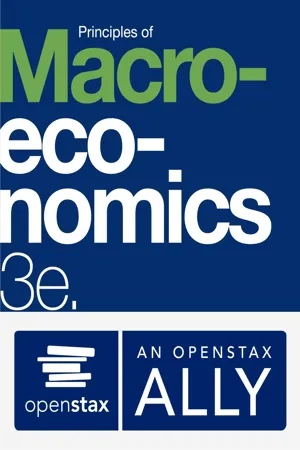Economics
AA Schedule
An AA schedule, also known as the Aggregate Expenditure schedule, represents the total planned spending in an economy at different levels of income. It shows the relationship between aggregate expenditure and national income, providing insights into the equilibrium level of income and output in an economy. This schedule is a key tool in analyzing the macroeconomic equilibrium and the impact of changes in spending.
Written by Perlego with AI-assistance
Related key terms
1 of 5
6 Key excerpts on "AA Schedule"
- eBook - ePub
Post-Keynesian Macroeconomics
Essays in Honour of Ingrid Rima
- Mathew Forstater, Gary Mongiovi, Steven Pressman(Authors)
- 2007(Publication Date)
- Routledge(Publisher)
r is the real rate of interest (Barro, 1984, p. 128).In Figure 7.6, the Cd (demand for commodities) or aggregate demand schedule is negatively sloped with respect to the real rate of interest, and the supply curve, Ys , is positively sloped. This formulation is not, however, the same as Hicks’ (1937) demand side IS/LM model. There may be an analogy between a standard IS curve and the Cd schedule. However, there is no direct discussion of monetary issues, and no analogue to the Hicksian LM curve. The model exhibits a purely “real theory of the real rate of interest” rather than a “monetary theory of the real rate of interest” (Burstein, 1995, p. 1), and the role of money is only to determine the price level (Barro, 1984, p. 130). The model infers aggregative schedules from a real theory of inter-temporal choice applied to a “representative agent,” with the marginal conditions:Figure 7.6 The market-clearing AD/AS model.where MRSC is the marginal rate of substitution between present and future consumption, MRSN is the marginal rate of substitution between work effort in the present and future, and the wi are real wage rates in both periods. From this exercise an argument can be constructed that an increase in the interest rate will reduce the demand for consumption goods in the current period, and at the same time increase work effort and the supply of output. This is the “inter-temporal substitution” theory of labor supply.In evaluating this argument, there are obvious problems with the attempt to derive specifically macroeconomic arguments from a purely individualistic theory of choice, even though this has become a methodological obiter dicta in the contemporary “microfoundations” literature. This point aside, however, in the context of the evolution of AD/AS analysis the most interesting feature of the re-labeling of the axes is that now neither of the schedules has a vertical slope. Therefore, at least in principle, there may now be scope once again for effective demand as a factor determining output and employment. Any increase in demand, not offset by a compensating shift in supply, must cause an increase in output and employment. Presumably, this was not the intention of the originators of the market-clearing model, and if the Cd ,Ys schedules really are only different facets of the same optimization problem, it may not work out this way as the schedules will not be independent. However, changing the domain of the exercise to r,Y - eBook - PDF
- David Shapiro, Daniel MacDonald, Steven A. Greenlaw(Authors)
- 2022(Publication Date)
- Openstax(Publisher)
The first conclusion, which is not exactly a hot news flash, is that an economic approach focused only on the supply side or only on the demand side can be only a partial success. We need to take into account both supply and demand. The second conclusion is that since Keynes’ law applies more accurately in the short run and Say’s law applies more accurately in the long run, the tradeoffs and connections between the three goals of macroeconomics may be different in the short run and the long run. 11.2 Building a Model of Aggregate Demand and Aggregate Supply LEARNING OBJECTIVES By the end of this section, you will be able to: • Explain the aggregate supply curve and how it relates to real GDP and potential GDP • Explain the aggregate demand curve and how it is influenced by price levels • Interpret the aggregate demand/aggregate supply model • Identify the point of equilibrium in the aggregate demand/aggregate supply model • Define short run aggregate supply and long run aggregate supply To build a useful macroeconomic model, we need a model that shows what determines total supply or total demand for the economy, and how total demand and total supply interact at the macroeconomic level. We call this the aggregate demand/aggregate supply model. This module will explain aggregate supply, aggregate demand, and the equilibrium between them. The following modules will discuss the causes of shifts in aggregate supply and aggregate demand. 274 11 • The Aggregate Demand/Aggregate Supply Model Access for free at openstax.org The Aggregate Supply Curve and Potential GDP Firms make decisions about what quantity to supply based on the profits they expect to earn. They determine profits, in turn, by the price of the outputs they sell and by the prices of the inputs, like labor or raw materials, that they need to buy. Aggregate supply (AS) refers to the total quantity of output (i.e. real GDP) firms will produce and sell. - eBook - PDF
- Steven A. Greenlaw, Timothy Taylor, David Shapiro(Authors)
- 2017(Publication Date)
- Openstax(Publisher)
Equilibrium in the Aggregate Demand/Aggregate Supply Model The intersection of the aggregate supply and aggregate demand curves shows the equilibrium level of real GDP and the equilibrium price level in the economy. At a relatively low price level for output, firms have little incentive to produce, although consumers would be willing to purchase a large quantity of output. As the price level rises, aggregate supply rises and aggregate demand falls until the equilibrium point is reached. Figure 24.6 combines the AS curve from Figure 24.3 and the AD curve from Figure 24.4 and places them both on a single diagram. In this example, the equilibrium point occurs at point E, at a price level of 90 and an output level of 8,800. 586 Chapter 24 | The Aggregate Demand/Aggregate Supply Model This OpenStax book is available for free at http://cnx.org/content/col12122/1.4 Figure 24.6 Aggregate Supply and Aggregate Demand The equilibrium, where aggregate supply (AS) equals aggregate demand (AD), occurs at a price level of 90 and an output level of 8,800. Confusion sometimes arises between the aggregate supply and aggregate demand model and the microeconomic analysis of demand and supply in particular markets for goods, services, labor, and capital. Read the following Clear It Up feature to gain an understanding of whether AS and AD are macro or micro. Are AS and AD macro or micro? These aggregate supply and demand models and the microeconomic analysis of demand and supply in particular markets for goods, services, labor, and capital have a superficial resemblance, but they also have many underlying differences. For example, the vertical and horizontal axes have distinctly different meanings in macroeconomic and microeconomic diagrams. The vertical axis of a microeconomic demand and supply diagram expresses a price (or wage or rate of return) for an individual good or service. - eBook - PDF
- Steven A. Greenlaw, David Shapiro, Daniel MacDonald(Authors)
- 2022(Publication Date)
- Openstax(Publisher)
The first conclusion, which is not exactly a hot news flash, is that an economic approach focused only on the supply side or only on the demand side can be only a partial success. We need to take into account both supply and demand. The second conclusion is that since Keynes’ law applies more accurately in the short run and Say’s law applies more accurately in the long run, the tradeoffs and connections between the three goals of macroeconomics may be different in the short run and the long run. 24.2 Building a Model of Aggregate Demand and Aggregate Supply LEARNING OBJECTIVES By the end of this section, you will be able to: • Explain the aggregate supply curve and how it relates to real GDP and potential GDP • Explain the aggregate demand curve and how it is influenced by price levels • Interpret the aggregate demand/aggregate supply model • Identify the point of equilibrium in the aggregate demand/aggregate supply model • Define short run aggregate supply and long run aggregate supply To build a useful macroeconomic model, we need a model that shows what determines total supply or total demand for the economy, and how total demand and total supply interact at the macroeconomic level. We call this the aggregate demand/aggregate supply model. This module will explain aggregate supply, aggregate demand, and the equilibrium between them. The following modules will discuss the causes of shifts in aggregate supply and aggregate demand. 584 24 • The Aggregate Demand/Aggregate Supply Model Access for free at openstax.org The Aggregate Supply Curve and Potential GDP Firms make decisions about what quantity to supply based on the profits they expect to earn. They determine profits, in turn, by the price of the outputs they sell and by the prices of the inputs, like labor or raw materials, that they need to buy. Aggregate supply (AS) refers to the total quantity of output (i.e. real GDP) firms will produce and sell. - eBook - ePub
Economics
The Definitive Encyclopedia from Theory to Practice [4 volumes]
- David A. Dieterle(Author)
- 2017(Publication Date)
- Greenwood(Publisher)
A AGGREGATE DEMAND AND AGGREGATE SUPPLYAggregate demand and aggregate supply are two of the primary concepts in macroeconomics. Aggregate means total, and demand is the desire and ability to purchase goods and services. Supply refers to the desire and ability of producers to provide goods and services. Aggregate demand is the total amount of goods and services demanded in an economy during a given time period, while aggregate supply is the total amount of goods and services provided. Aggregate demand is composed of all consumer spending, investment spending, government spending, and net exports (exports–imports)—the components of gross domestic product (GDP). Aggregate supply is composed of all income, in the forms of wages, rents, profits, and interest earned.The British economist John Maynard Keynes (1883–1946) is credited with creating the concepts of aggregate demand and aggregate supply. He used these concepts in the 1930s to explain how governments can recover from recessions by increasing government spending to impact aggregate demand, which in turn would increase aggregate supply. Keynes did the lion’s share of his writing and economic thought from 1920 to 1940. Prior to Keynes, market explanations centered on classical economics, popularized by the writings of Adam Smith (1723–1790). Smith emphasized the market concept of laissez faire, which is the minimal use of government actions to control economic activity.Aggregate demand and aggregate supply are graphed on the aggregate demand and aggregate supply graph with the y-axis being the general price level, or CPI, and the x-axis being real GDP. The aggregate demand curve is downward-sloping to the right while the aggregate supply curve is upward-sloping.Aggregate DemandMost economists support the downward-sloping aggregate demand (AD) curve for three primary reasons: the wealth effect, the interest rate effect, and the exchange rate effect. All three of the explanations for the downward-sloping AD curve center around lower prices, which induce greater quantity demanded and the downward slope of the AD curve. When the price level falls, wages do not change immediately, which makes consumers feel wealthier so they purchase more goods and services than before. When interest rates fall, consumer spending on durable goods such as homes and cars and business investments on capital goods will increase. When the domestic exchange rate falls, domestic exports become relatively cheaper to foreign consumers and foreign sales will increase. - eBook - PDF
- William Boyes, Michael Melvin(Authors)
- 2015(Publication Date)
- Cengage Learning EMEA(Publisher)
§ 8-5a • In the short run, a shift in aggregate demand estab-lishes a new, but temporary, equilibrium along the short-run aggregate supply curve. § 8-5a • In the long run, the short-run aggregate supply curve shifts so that changes in aggregate demand determine the price level but not the equilibrium level of output or real GDP. § 8-5b R E C A P 1. The equilibrium price level and real GDP are at the point where the aggregate demand and ag-gregate supply curves intersect. 2. In the short run, a shift in aggregate demand establishes a temporary equilibrium along the short-run aggregate supply curve. 3. In the long run, the short-run aggregate supply curve shifts so that changes in aggregate demand affect only the price level, not the equi-librium level of output or real GDP. Chapter 8 Macroeconomic Equilibrium: Aggregate Demand and Supply 167 Copyright 2016 Cengage Learning. All Rights Reserved. May not be copied, scanned, or duplicated, in whole or in part. Due to electronic rights, some third party content may be suppressed from the eBook and/or eChapter(s). Editorial review has deemed that any suppressed content does not materially affect the overall learning experience. Cengage Learning reserves the right to remove additional content at any time if subsequent rights restrictions require it. K E Y T E R M S aggregate demand curve, 147 aggregate supply curve, 147 cost-push inflation, 149 demand-pull inflation, 147 interest rate effect, 153 international trade effect, 153 long-run aggregate supply curve (LRAS), 159 wealth effect, 152 E X E R C I S E S 1. How is the aggregate demand curve different from the demand curve for a single good, like hamburgers? 2. Why does the aggregate demand curve slope down-ward? Give real-world examples of the three effects that explain the slope of the curve. 3. How does an increase in foreign income affect domestic aggregate expenditures and demand? Draw a diagram to illustrate your answer.
Index pages curate the most relevant extracts from our library of academic textbooks. They’ve been created using an in-house natural language model (NLM), each adding context and meaning to key research topics.





